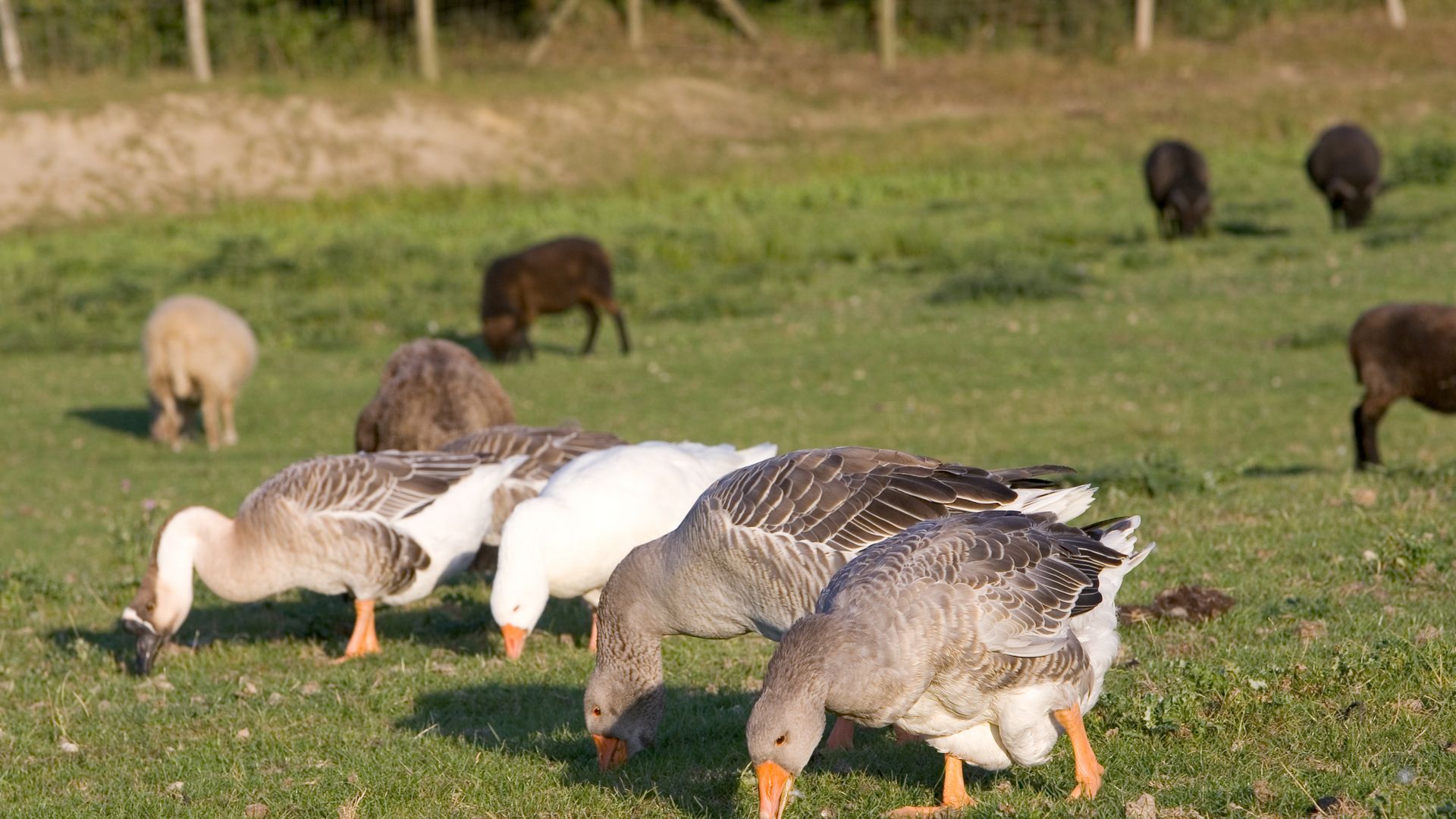
Why the wind may be partly to blame for the spread of bird flu: Study
By Jack Aylmer (Anchor), Evan Hummel (Producer), Shianne DeLeon (Video Editor)
- Czech Republic researchers said the wind may be partly to blame for the spread of bird flu. The newly released study said that the virus may be spreading in part because of infected feces particles blowing in the wind.
- Scientists told CNN that many of the birds impacted by the virus are migratory species like geese and ducks, which often rest on farms, where they are likely to defecate.
- The wind can then pick up the infected particles, spreading the virus far and wide, according to researchers.
Full Story
Czech Republic researchers said the wind may be partly to blame for the spread of bird flu. The study, released on Feb. 12, said that the virus may be spreading in part because of infected feces particles blowing in the wind, noting cases of people and farm flocks with no known exposure to H5N1 becoming infected with the virus.
Media Landscape
See how news outlets across the political spectrum are covering this story. Learn moreBias Summary
- Migratory waterfowl, such as geese and ducks, are primarily affected by bird flu, according to Osterholm.
- The wind can carry particles of infected feces from these birds, spreading the virus.
- Dr. Kamil Sedlak, of the State Veterinary Institute in Prague, identified windborne spread as the best explanation after exploring possibilities.
- The risk of human infection from windborne spread is low, according to Dr. Kamil Sedlak.
- There have been 89 confirmed flocks with high path avian influenza in the last 30 days, according to Osterholm.
- Migratory waterfowl, such as geese and ducks, are primarily affected by the flu, as reported by Osterholm.
- Wind may help spread bird flu between farms, as noted by Osterholm.
- Osterholm believes that egg prices will remain high until poultry facilities implement better protections against the virus.
- No summary available because of a lack of coverage.
Bias Comparison
Bias Distribution
Left
Right
Untracked Bias
What did scientists find?
Scientists told CNN that many of the birds impacted by the virus are migratory species like geese and ducks, which often land on farms, where they defecate. The wind may then pick up the infected particles, spreading the virus far and wide, according to researchers.

Download the SAN app today to stay up-to-date with Unbiased. Straight Facts™.
Point phone camera here
How many cases spread this way?
Researchers said the true number of cases contracted through this method is hard to measure.
Health officials in California also believe that wind may have played a factor in the spread of the virus in some cattle herds in the Central Valley.
What evidence do they have for their theory?
In the case of infections reported at a chicken farm in the Czech Republic, researchers suspected the origins of the outbreak came from a nearby duck farm, which saw the virus spread rapidly through its flocks a week earlier.
Researchers also noted that ducks, exposed to a more open-air environment than chickens, died at a higher pace. This suggests that the ventilation systems at the studied chicken farm may have led to a slower spread of H5N1 through its flock.
When researchers checked the weather patterns during the chickens’ infection period, they found infections in chickens spread when there was a steady breeze blowing in from the duck farm, and when temperatures were between 40 and 50 degrees. Epidemiologists say viruses’ travel well in cold air and can survive long trips.
Scientists said they believe the virus may have hitched a ride on some of the feces-filled dander from the ducks.
Epidemiologists also note that this could partly explain human infections with no known prior exposure to the virus, though the evidence is still unclear.
Get up to speed on the stories leading the day every weekday morning. Sign up for the newsletter today!
Learn more about our emails. Unsubscribe anytime.
By entering your email, you agree to the Terms & Conditions and acknowledge the Privacy Policy.
What do the findings mean for the bigger picture?
Researchers said the new findings show that people should take a layered approach when protecting themselves and livestock from the virus, including wearing personal protective equipment (PPE), and filtering air in barns to protect animals and farmworkers.
[JACK AYLMER]
CZECH RESEARCHERS SAY THE WIND MAY BE PARTLY TO BLAME FOR THE SPREAD OF BIRD FLU.
REVEALING IN A STUDY, THE VIRUS MAY BE SPREADING IN PART BECAUSE OF INFECTED FECES PARTICLES BLOWING IN THE WIND, NOTING CASES OF PEOPLE AND FARM FLOCKS WITH NO KNOWN EXPOSURE TO H-5-N-1 BECOMING INFECTED.
SCIENTISTS TELL C-N-N, MANY OF THE BIRDS IMPACTED BY THE VIRUS ARE MIGRATORY SPECIES LIKE GEESE AND DUCKS, WHICH OFTEN HANG OUT ON FARMS WHERE THEY DEFECATE.
THE WIND PICKS UP THE INFECTED PARTICLES, SPREADING THE VIRUS FAR AND WIDE, ACCORDING TO RESEARCHERS.
RESEARCHERS, HOWEVER, SAY THE TRUE NUMBER OF CASES THROUGH THIS METHOD IS HARD MEASURE.
HEALTH OFFICIALS IN CALIFORNIA ALSO BELIEVE WIND MAY HAVE PLAYED A FACTOR IN THE SPREAD OF THE VIRUS TO SOME CATTLE HERDS IN THE CENTRAL VALLEY.
IN THE CASE INFECTIONS REPORTED AT A CHICKEN FARM IN THE CZECH REPUBLIC, RESEARCHERS SUSPECT THE ORIGINS OF THE OUTBREAK CAME FROM A NEARBY DUCK FARM, WHICH SAW THE VIRUS SPREAD RAPIDLY THROUGH ITS FLOCKS A WEEK EARLIER.
RESEARCHERS ALSO NOTE, THE DUCKS WHICH WERE EXPOSED TO AN OPEN-AIR ENVIRONMENT UNLIKE THE CHICKENS, DIED AT A MORE RAPID PACE THAN THE CHICKENS.
SUGGESTING VENTILATION SYSTEMS AT THE CHICKEN FARM MAY HAVE LED TO A SLOWER SPREAD OF H-5-N-1 THROUGH ITS FLOCK.
WHEN RESEARCHERS CHECKED THE WEATHER PATTERNS DURING THE CHICKENS INFECTION PERIOD, THEY FOUND INFECTIONS IN CHICKENS SPREAD WHEN THERE WAS A STEADY BREEZE BLOWING IN FROM THE DUCK FARM AND TEMPERATURES WERE BETWEEN 40 AND 50 DEGREES.
EPIDEMOLOGISTS SAY VIRUS’ TRAVEL WELL IN COLD AIR AND CAN SURVIVE A LONG TRIP.
SCIENTISTS BELIEVE THE VIRUS MAY HAVE ALSO HITCHED A RIDE ON SOME OF THE FECES-FILLED-DANDER FROM THE DUCKS.
EPIDEMOLOGISTS ALSO NOTE, THIS COULD PARTLY EXPLAIN HUMAN INFECTIONS WITH NO KNOWN PRIOR EXPOSURE TO THE VIRUS, THOUGH THE EVIDENCE IS STILL UNCLEAR.
RESEARCHERS SAY THE NEW FINDINGS SHOW PEOPLE SHOULD TAKE A LAYERED APPROACH WHEN PROTECTING THEMSELVES AND LIVESTOCK FROM THE VIRUS.
INCLUDING WEARING PERSONAL PROTECTIVE GEAR AND FILTERING AIR IN BARNS TO PROTECT ANIMALS AND FARMWORKERS.
FOR MORE ON THIS STORY– DOWNLOAD THE STRAIGHT ARROW NEWS APP OR VISIT SAN DOT COM.
FOR STRAIGHT ARROW NEWS– I’M JACK AYLMER.
Media Landscape
See how news outlets across the political spectrum are covering this story. Learn moreBias Summary
- Migratory waterfowl, such as geese and ducks, are primarily affected by bird flu, according to Osterholm.
- The wind can carry particles of infected feces from these birds, spreading the virus.
- Dr. Kamil Sedlak, of the State Veterinary Institute in Prague, identified windborne spread as the best explanation after exploring possibilities.
- The risk of human infection from windborne spread is low, according to Dr. Kamil Sedlak.
- There have been 89 confirmed flocks with high path avian influenza in the last 30 days, according to Osterholm.
- Migratory waterfowl, such as geese and ducks, are primarily affected by the flu, as reported by Osterholm.
- Wind may help spread bird flu between farms, as noted by Osterholm.
- Osterholm believes that egg prices will remain high until poultry facilities implement better protections against the virus.
- No summary available because of a lack of coverage.
Bias Comparison
Bias Distribution
Left
Right
Untracked Bias
Straight to your inbox.
By entering your email, you agree to the Terms & Conditions and acknowledge the Privacy Policy.
MOST POPULAR
-
 RICHARD PIERRIN/AFP via Getty Images
RICHARD PIERRIN/AFP via Getty Images
Haiti’s capital could fall to armed gangs at any moment: Report
Watch 2:0618 hrs ago -
 IAF
IAF
Israel first to go ‘Beast Mode’ with F-35 fighter in combat
Watch 2:0518 hrs ago -
 Drew Angerer/Getty Images
Drew Angerer/Getty Images
Hunter Biden’s ex-business partner reveals ‘pardon’ conversation with Trump
Watch 2:2219 hrs ago -
 Artur Widak/NurPhoto via Getty Images
Artur Widak/NurPhoto via Getty Images
Canada updates travel guidance for residents heading to US
Watch 2:2020 hrs ago




